实验5 C语言指针应用编程
四、实验结论
1. 实验任务1
task1_1.c
1 #include <stdio.h> 2 #define N 5 3 4 void input(int x[], int n); 5 void output(int x[], int n); 6 void find_min_max(int x[], int n, int *pmin, int *pmax); 7 8 int main() { 9 int a[N]; 10 int min, max; 11 12 printf("录入%d个数据:\n", N); 13 input(a, N); 14 15 printf("数据是: \n"); 16 output(a, N); 17 18 printf("数据处理...\n"); 19 find_min_max(a, N, &min, &max); 20 21 printf("输出结果:\n"); 22 printf("min = %d, max = %d\n", min, max); 23 24 return 0; 25 } 26 27 void input(int x[], int n) { 28 int i; 29 30 for(i = 0; i < n; ++i) 31 scanf("%d", &x[i]); 32 } 33 34 void output(int x[], int n) { 35 int i; 36 37 for(i = 0; i < n; ++i) 38 printf("%d ", x[i]); 39 printf("\n"); 40 } 41 42 void find_min_max(int x[], int n, int *pmin, int *pmax) { 43 int i; 44 45 *pmin = *pmax = x[0]; 46 47 for(i = 1; i < n; ++i) 48 if(x[i] < *pmin) 49 *pmin = x[i]; 50 else if(x[i] > *pmax) 51 *pmax = x[i]; 52 }
运行截图:

回答问题:
- 函数find_min_max实现的功能是找到数组x中的最大值和最小值;
- 在执行到line45时,指针指向数组的第一个元素。
task1_2.c
1 #include <stdio.h> 2 #define N 5 3 4 void input(int x[], int n); 5 void output(int x[], int n); 6 int *find_max(int x[], int n); 7 8 int main() { 9 int a[N]; 10 int *pmax; 11 12 printf("录入%d个数据:\n", N); 13 input(a, N); 14 15 printf("数据是: \n"); 16 output(a, N); 17 18 printf("数据处理...\n"); 19 pmax = find_max(a, N); 20 21 printf("输出结果:\n"); 22 printf("max = %d\n", *pmax); 23 24 return 0; 25 } 26 27 void input(int x[], int n) { 28 int i; 29 30 for(i = 0; i < n; ++i) 31 scanf("%d", &x[i]); 32 } 33 34 void output(int x[], int n) { 35 int i; 36 37 for(i = 0; i < n; ++i) 38 printf("%d ", x[i]); 39 printf("\n"); 40 } 41 42 int *find_max(int x[], int n) { 43 int max_index = 0; 44 int i; 45 46 for(i = 1; i < n; ++i) 47 if(x[i] > x[max_index]) 48 max_index = i; 49 50 return &x[max_index]; 51 }
运行截图:

回答问题:
- 函数find_max的功能是寻找数组x中的最大值,并返回该元素的地址;
- find_max可以改写成该形式。
2. 实验任务2
task2_1.c
1 #include <stdio.h> 2 #include <string.h> 3 #define N 80 4 5 int main() { 6 char s1[] = "Learning makes me happy"; 7 char s2[] = "Learning makes me sleepy"; 8 char tmp[N]; 9 10 printf("sizeof(s1) vs. strlen(s1): \n"); 11 printf("sizeof(s1) = %d\n", sizeof(s1)); 12 printf("strlen(s1) = %d\n", strlen(s1)); 13 14 printf("\nbefore swap: \n"); 15 printf("s1: %s\n", s1); 16 printf("s2: %s\n", s2); 17 18 printf("\nswapping...\n"); 19 strcpy(tmp, s1); 20 strcpy(s1, s2); 21 strcpy(s2, tmp); 22 23 printf("\nafter swap: \n"); 24 printf("s1: %s\n", s1); 25 printf("s2: %s\n", s2); 26 27 return 0; 28 }
运行截图:
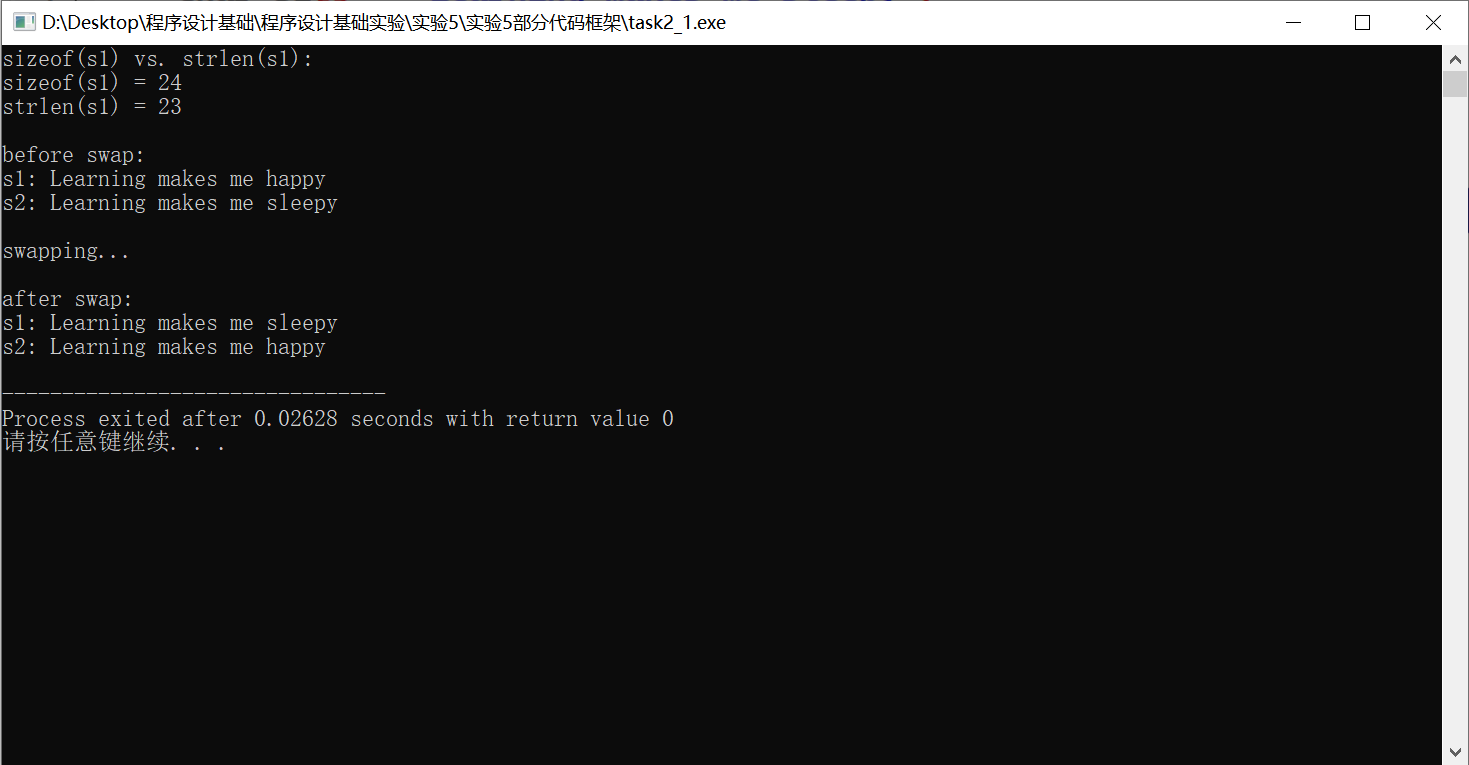
回答问题:
- s1数组的大小是24,sizeof(s1)计算的是数组的长度,strlen(s1)计算的是该字符串的长度,由于在初始化字符串时,系统会自动在末尾加上'\0',因此sizeof()计算的数值会比strlen()计算的数组多1;
- 不可以,C语言中给字符串赋值不可以直接使用=,需要借助strcpy()等函数的辅助,才可以实现字符串的赋值;
- 交换了。
task2_2.c
1 #include <stdio.h> 2 #include <string.h> 3 #define N 80 4 5 int main() { 6 char *s1 = "Learning makes me happy"; 7 char *s2 = "Learning makes me sleepy"; 8 char *tmp; 9 10 printf("sizeof(s1) vs. strlen(s1): \n"); 11 printf("sizeof(s1) = %d\n", sizeof(s1)); 12 printf("strlen(s1) = %d\n", strlen(s1)); 13 14 printf("\nbefore swap: \n"); 15 printf("s1: %s\n", s1); 16 printf("s2: %s\n", s2); 17 18 printf("\nswapping...\n"); 19 tmp = s1; 20 s1 = s2; 21 s2 = tmp; 22 23 printf("\nafter swap: \n"); 24 printf("s1: %s\n", s1); 25 printf("s2: %s\n", s2); 26 27 return 0; 28 }
运行截图:
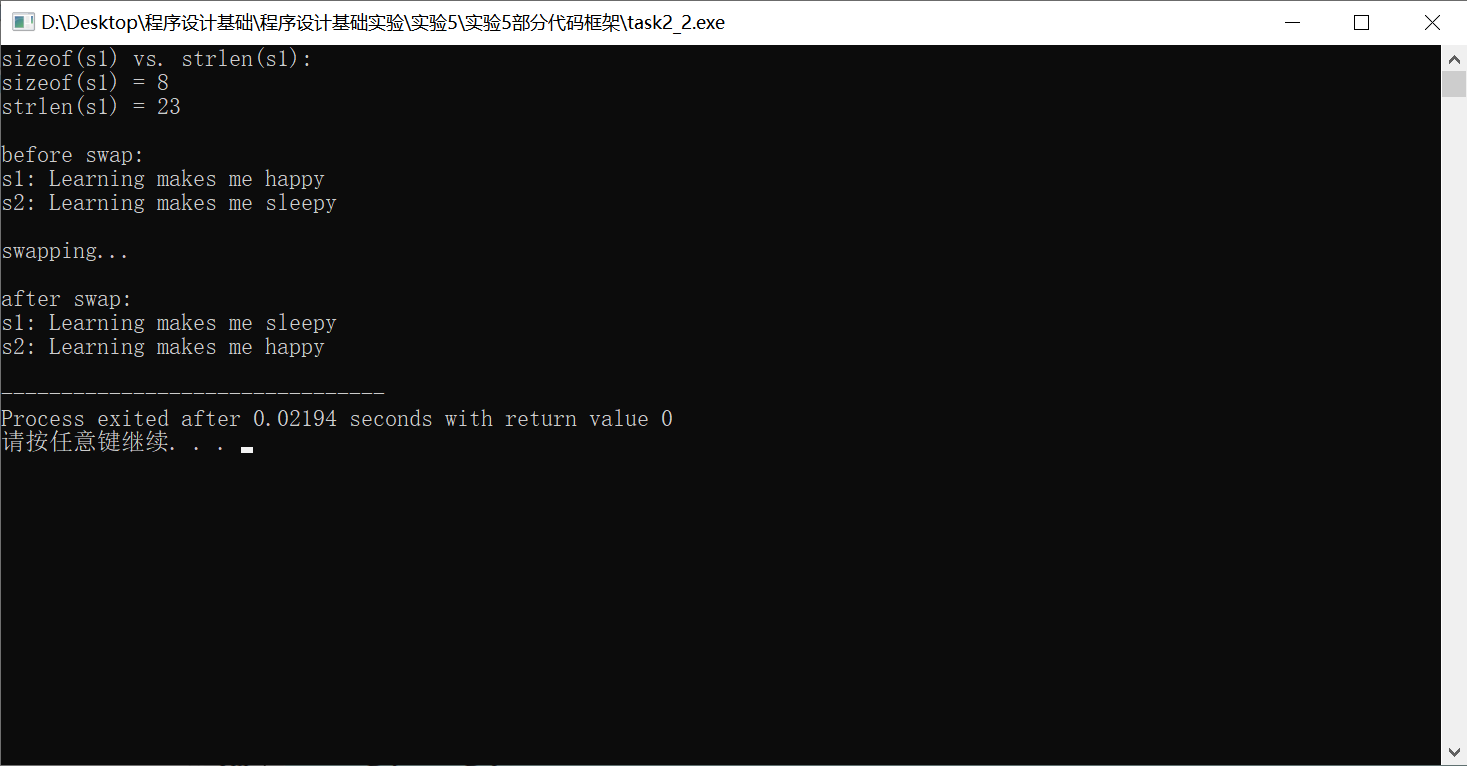
回答问题:
- sizeof(s1)计算的是该指针所占字节数,即计算的是该系统的地址字节数,strlen(s1)计算的是该字符串的长度23;
- 可以,task2_1.c中line6的s1仅仅是一个数组名,在赋值是不能直接使用=,而task2_2.c中s1是一个字符的指针,可以直接对其进行赋值;
- s1与s2交换的是指针指向的内存的位置,两个字符串的本身的物理位置并没有发生改变。
3. 实验任务3
task3.c
1 #include <stdio.h> 2 3 #include <stdio.h> 4 5 int main() { 6 int x[2][4] = {{1, 9, 8, 4}, {2, 0, 4, 9}}; 7 int i, j; 8 int *ptr1; // 指针变量,存放int类型数据的地址 9 int(*ptr2)[4]; // 指针变量,指向包含4个int元素的一维数组 10 11 printf("输出1: 使用数组名、下标直接访问二维数组元素\n"); 12 for (i = 0; i < 2; ++i) { 13 for (j = 0; j < 4; ++j) 14 printf("%d ", x[i][j]); 15 printf("\n"); 16 } 17 18 printf("\n输出2: 使用指向元素的指针变量p间接访问二维数组元素\n"); 19 for (ptr1 = &x[0][0], i = 0; ptr1 < &x[0][0] + 8; ++ptr1, ++i) { 20 printf("%d ", *ptr1); 21 22 if ((i + 1) % 4 == 0) 23 printf("\n"); 24 } 25 26 printf("\n输出3: 使用指向一维数组的指针变量q间接访问二维数组元素\n"); 27 for (ptr2 = x; ptr2 < x + 2; ++ptr2) { 28 for (j = 0; j < 4; ++j) 29 printf("%d ", *(*ptr2 + j)); 30 printf("\n"); 31 } 32 33 return 0; 34 }
运行截图:
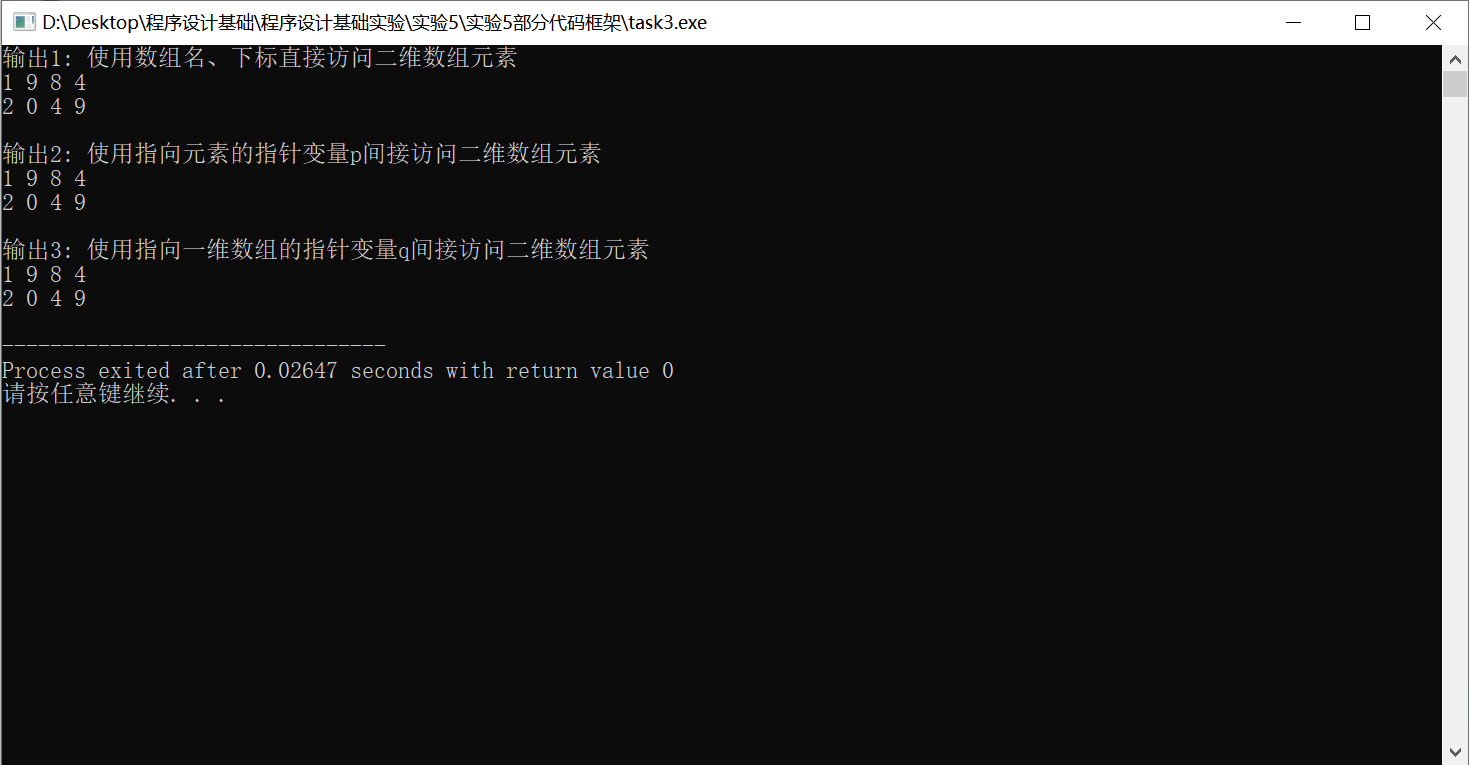
回答问题:
- (*ptr)[4]代表的是指向一个有4个元素的一维数组;
- *ptr[4]代表的是一个有4个指向int型指针组成的一维数组。
4. 实验任务4
task4_1.c
1 #include <stdio.h> 2 #define N 80 3 4 void replace(char *str, char old_char, char new_char); // 函数声明 5 6 int main() { 7 char text[N] = "c programming is difficult or not, it is a question."; 8 9 printf("原始文本: \n"); 10 printf("%s\n", text); 11 12 replace(text, 'i', '*'); // 函数调用 注意字符形参写法,单引号不能少 13 14 printf("处理后文本: \n"); 15 printf("%s\n", text); 16 17 return 0; 18 } 19 20 // 函数定义 21 void replace(char *str, char old_char, char new_char) { 22 int i; 23 24 while(*str) { 25 if(*str == old_char) 26 *str = new_char; 27 str++; 28 } 29 }
运行截图:
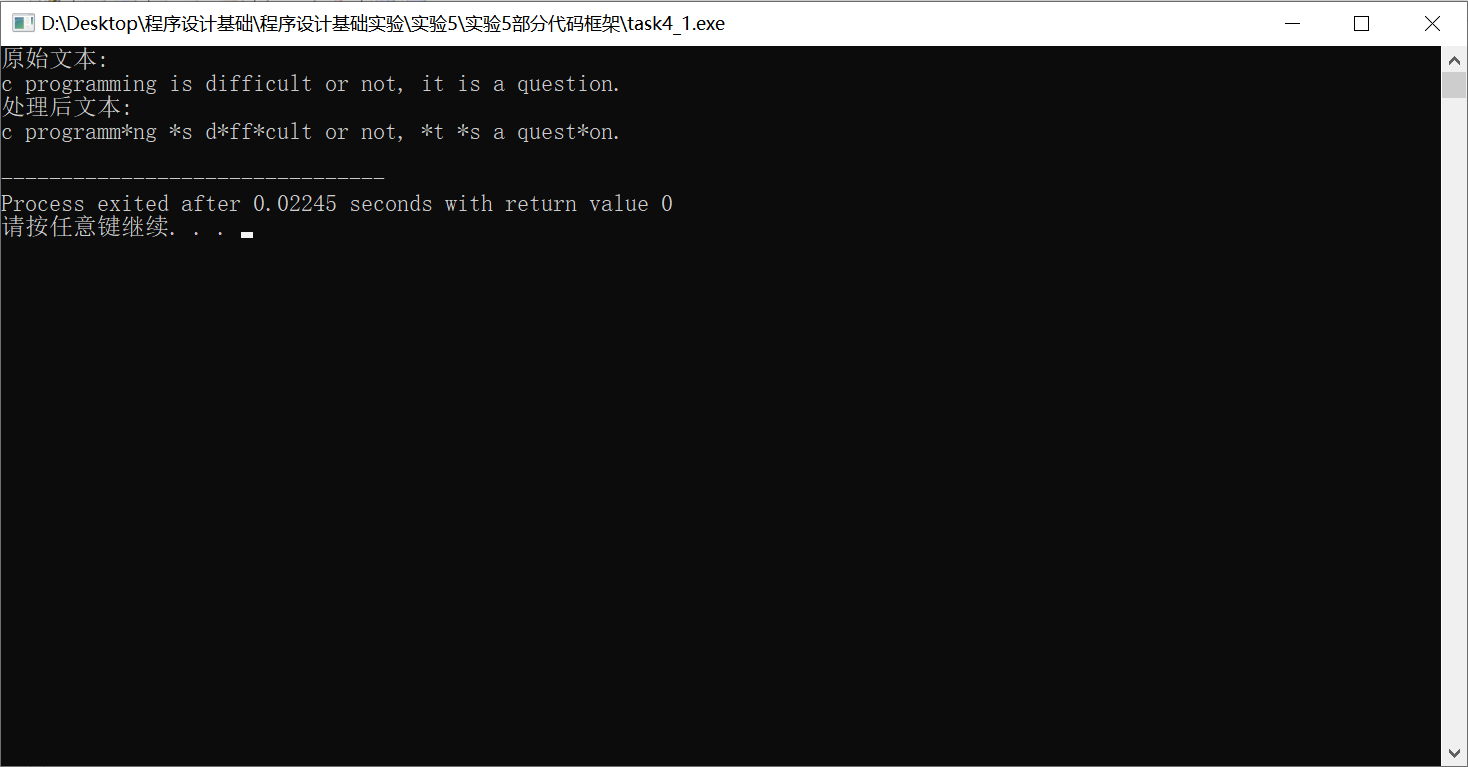
回答问题:
- 函数replace的功能是:将该字符串中的所有字符'i'替换成'*';
- 可以。
task4_2.c
1 #include <stdio.h> 2 #define N 80 3 4 void str_trunc(char *str, char x); 5 6 int main() { 7 char str[N]; 8 char ch; 9 10 printf("输入字符串: "); 11 gets(str); 12 13 printf("输入一个字符: "); 14 ch = getchar(); 15 16 printf("截断处理...\n"); 17 str_trunc(str, ch); 18 19 printf("截断处理后的字符串: %s\n", str); 20 21 } 22 23 void str_trunc(char *str, char x) { 24 while(*str) { 25 if(*str == x) 26 *str = '\0'; // blank1 27 28 str++; // blank2 29 } 30 31 return; // blank3 32 }
运行截图:

5. 实验任务5
task5_1.c
1 #include <stdio.h> 2 #include <string.h> 3 void sort(char *name[], int n); 4 5 int main() { 6 char *course[4] = {"C Program", 7 "C++ Object Oriented Program", 8 "Operating System", 9 "Data Structure and Algorithms"}; 10 int i; 11 12 sort(course, 4); 13 14 for (i = 0; i < 4; i++) 15 printf("%s\n", course[i]); 16 17 return 0; 18 } 19 20 void sort(char *name[], int n) { 21 int i, j; 22 char *tmp; 23 24 for (i = 0; i < n - 1; ++i) 25 for (j = 0; j < n - 1 - i; ++j) 26 if (strcmp(name[j], name[j + 1]) > 0) { 27 tmp = name[j]; 28 name[j] = name[j + 1]; 29 name[j + 1] = tmp; 30 } 31 }
运行截图:
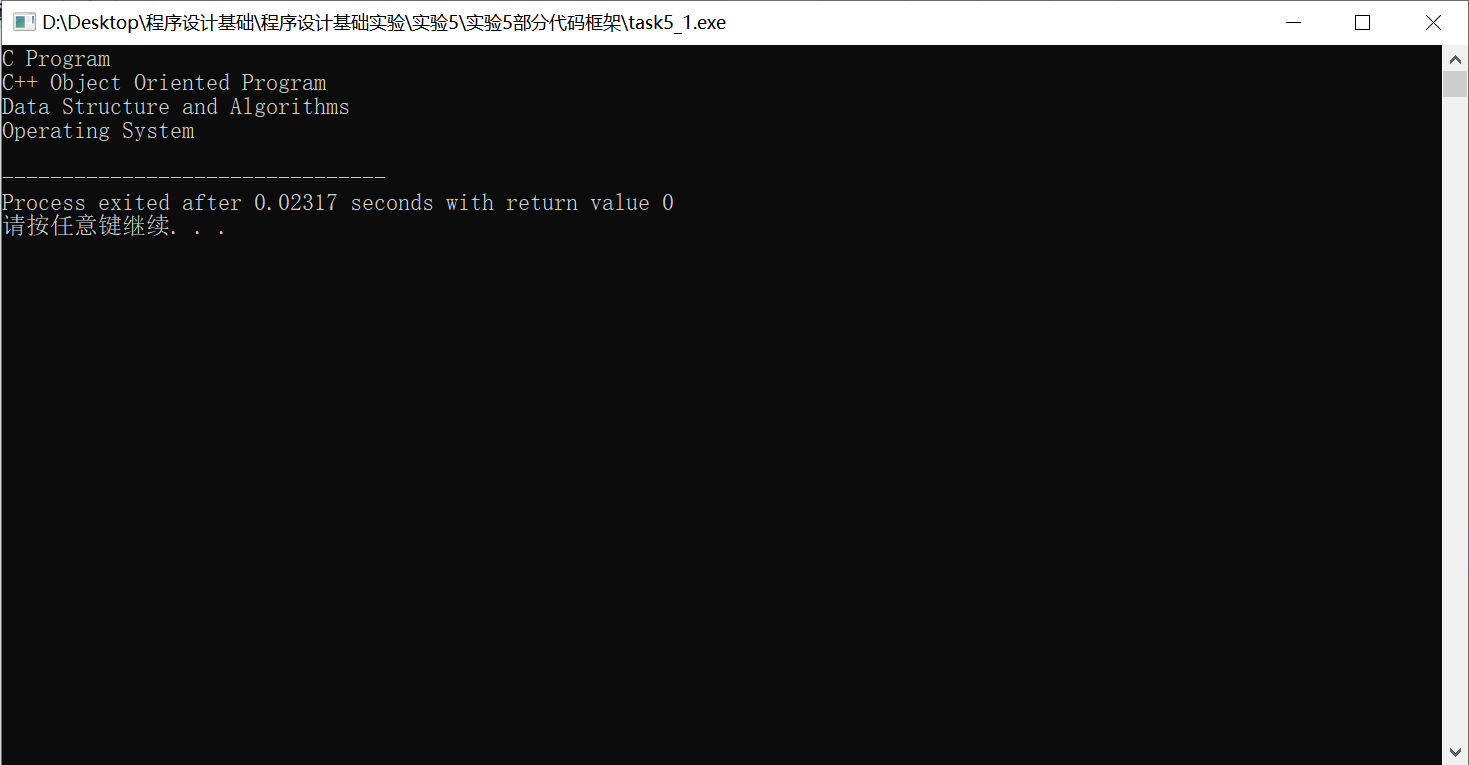
task5_2.c
1 #include <stdio.h> 2 #include <string.h> 3 void sort(char *name[], int n); 4 5 int main() { 6 char *course[4] = {"C Program", 7 "C++ Object Oriented Program", 8 "Operating System", 9 "Data Structure and Algorithms"}; 10 int i; 11 12 sort(course, 4); 13 for (i = 0; i < 4; i++) 14 printf("%s\n", course[i]); 15 16 return 0; 17 } 18 19 void sort(char *name[], int n) { 20 int i, j, k; 21 char *tmp; 22 23 for (i = 0; i < n - 1; i++) { 24 k = i; 25 for (j = i + 1; j < n; j++) 26 if (strcmp(name[j], name[k]) < 0) 27 k = j; 28 29 if (k != i) { 30 tmp = name[i]; 31 name[i] = name[k]; 32 name[k] = tmp; 33 } 34 } 35 }
运行截图:

回答问题:
在这两种排序中,均是仅仅改变了指针变量的值,而字符串所在位置的物理地址并未改变。
6. 实验任务6
task6.c
1 #include <stdio.h> 2 #include <string.h> 3 #define N 5 4 5 int check_id(char *str); // 函数声明 6 7 int main() { 8 char *pid[N] = {"31010120000721656X", 9 "330106199609203301", 10 "53010220051126571", 11 "510104199211197977", 12 "53010220051126133Y"}; 13 int i; 14 15 for (i = 0; i < N; ++i) 16 if (check_id(pid[i])) // 函数调用 17 printf("%s\tTrue\n", pid[i]); 18 else 19 printf("%s\tFalse\n", pid[i]); 20 21 return 0; 22 } 23 24 // 函数定义 25 // 功能: 检查指针str指向的身份证号码串形式上是否合法。 26 // 形式合法,返回1,否则,返回0 27 int check_id(char *str) { 28 // 补足函数实现 29 // ... 30 if (strlen(str) != 18) { 31 return 0; 32 } 33 while (*str) { 34 if (!(*str == 'X' || *str == 'Y' || (*str >= '0' && *str <= '9'))){ 35 return 0; 36 } 37 str++; 38 } 39 40 return 1; 41 }
运行截图:

7. 实验任务7
task7.c
1 #include <stdio.h> 2 #define N 80 3 void encoder(char *str); // 函数声明 4 void decoder(char *str); // 函数声明 5 6 int main() { 7 char words[N]; 8 9 printf("输入英文文本: "); 10 gets(words); 11 12 printf("编码后的英文文本: "); 13 encoder(words); // 函数调用 14 printf("%s\n", words); 15 16 printf("对编码后的英文文本解码: "); 17 decoder(words); // 函数调用 18 printf("%s\n", words); 19 20 return 0; 21 } 22 23 /*函数定义 24 功能:对s指向的字符串进行编码处理 25 编码规则: 26 对于a~z或A~Z之间的字母字符,用其后的字符替换; 其中,z用a替换,Z用A替换 27 其它非字母字符,保持不变 28 */ 29 void encoder(char *str) { 30 // 补足函数实现 31 // ××× 32 while (*str) { 33 if (*str == 'z') { 34 *str = 'a'; 35 } 36 else if (*str == 'Z') { 37 *str = 'A'; 38 } 39 else { 40 (*str)++; 41 } 42 43 str++; 44 } 45 } 46 47 /*函数定义 48 功能:对s指向的字符串进行解码处理 49 解码规则: 50 对于a~z或A~Z之间的字母字符,用其前面的字符替换; 其中,a用z替换,A用Z替换 51 其它非字母字符,保持不变 52 */ 53 void decoder(char *str) { 54 // 补足函数实现 55 // ××× 56 while (*str) { 57 if (*str == 'a'){ 58 *str = 'z'; 59 } 60 else if (*str == 'A') { 61 *str = 'Z'; 62 } 63 else { 64 (*str)--; 65 } 66 str++; 67 } 68 }
运行截图:
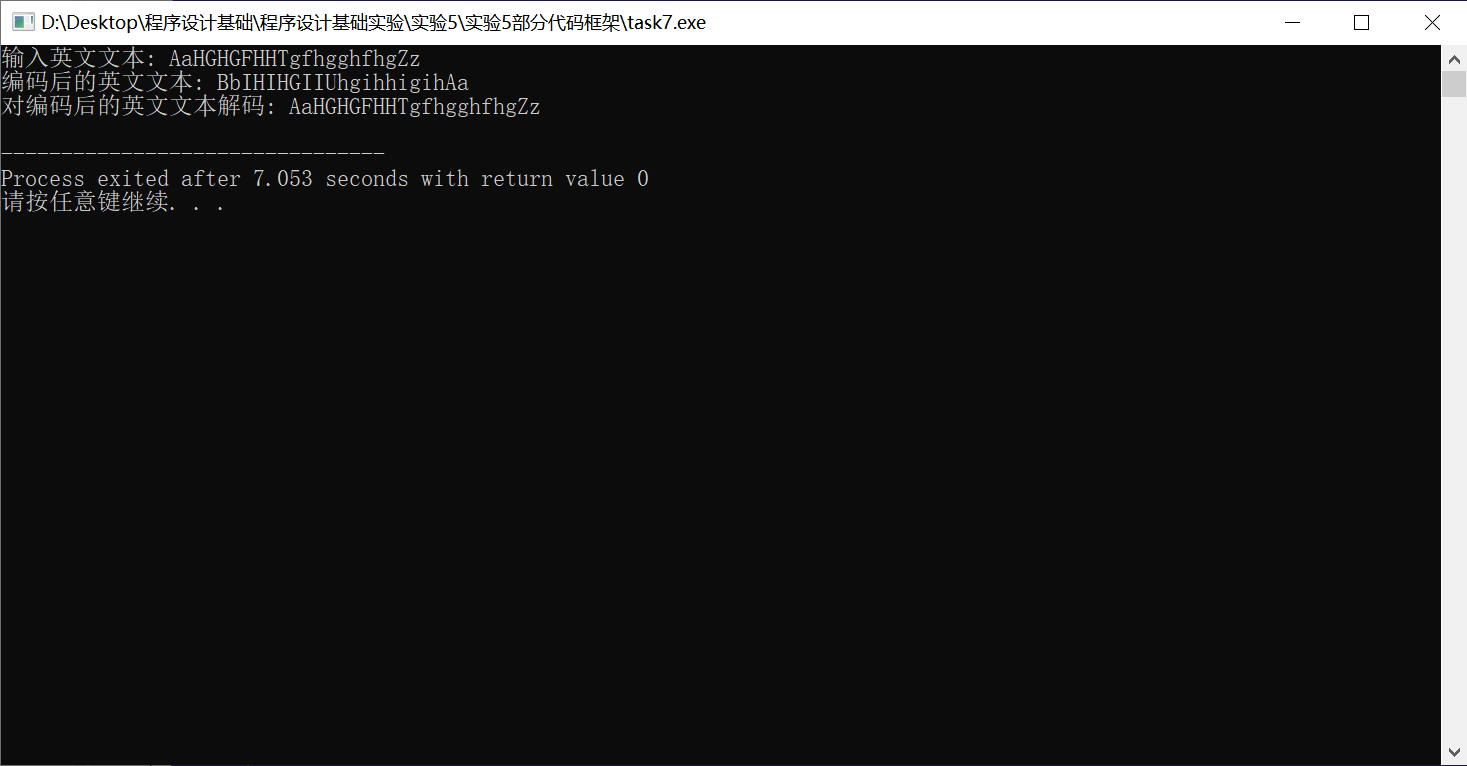
8. 实验任务8
task8.c
1 #include <stdio.h> 2 3 int main(int argc, char *argv[]) { 4 int i; 5 6 sort(argv, argc); 7 for(i = 1; i < argc; ++i) 8 printf("hello, %s\n", argv[i]); 9 10 return 0; 11 } 12 13 void sort(char *name[], int n) { 14 int i, j; 15 char *tmp; 16 17 for (i = 0; i < n - 1; ++i) 18 for (j = 0; j < n - 1 - i; ++j) 19 if (strcmp(name[j], name[j + 1]) > 0) { 20 tmp = name[j]; 21 name[j] = name[j + 1]; 22 name[j + 1] = tmp; 23 } 24 }
运行截图:
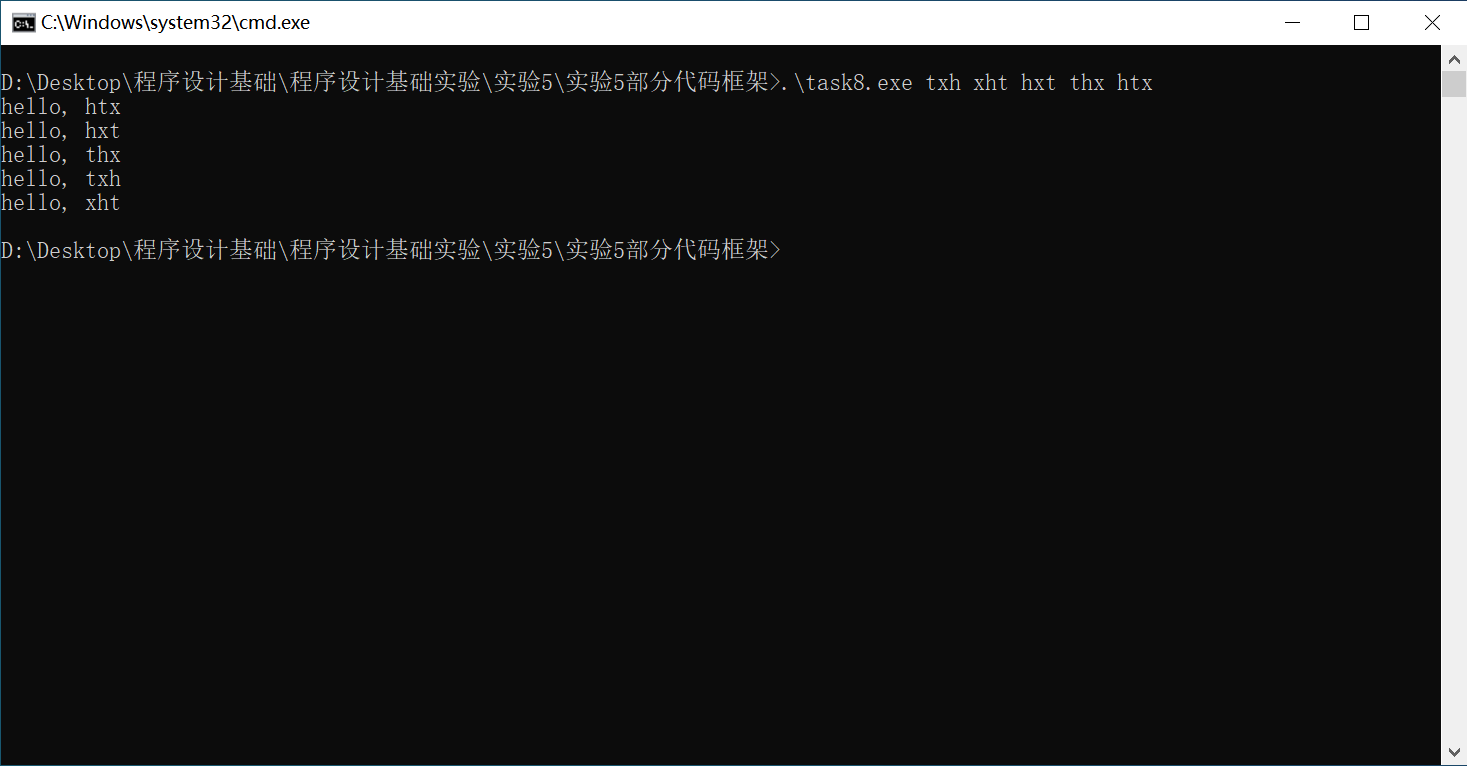



 浙公网安备 33010602011771号
浙公网安备 33010602011771号